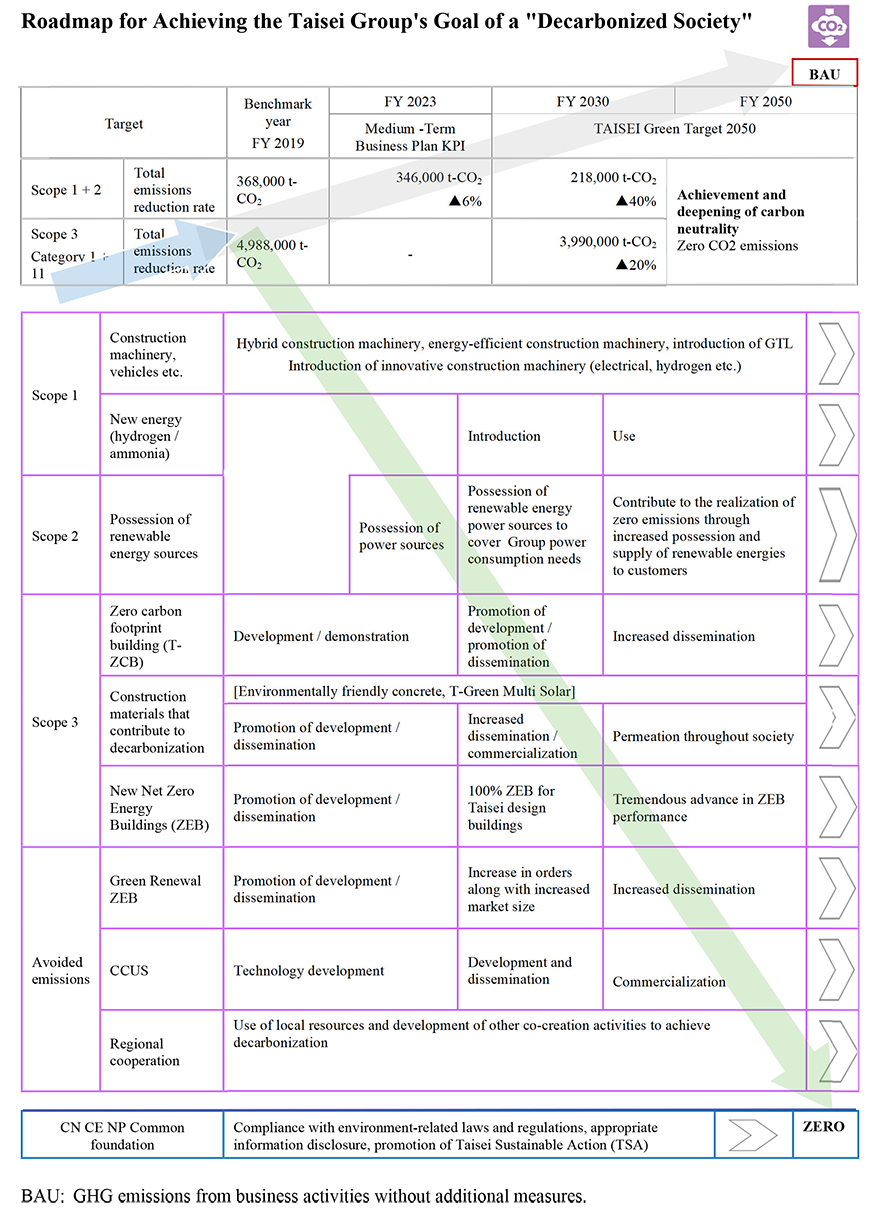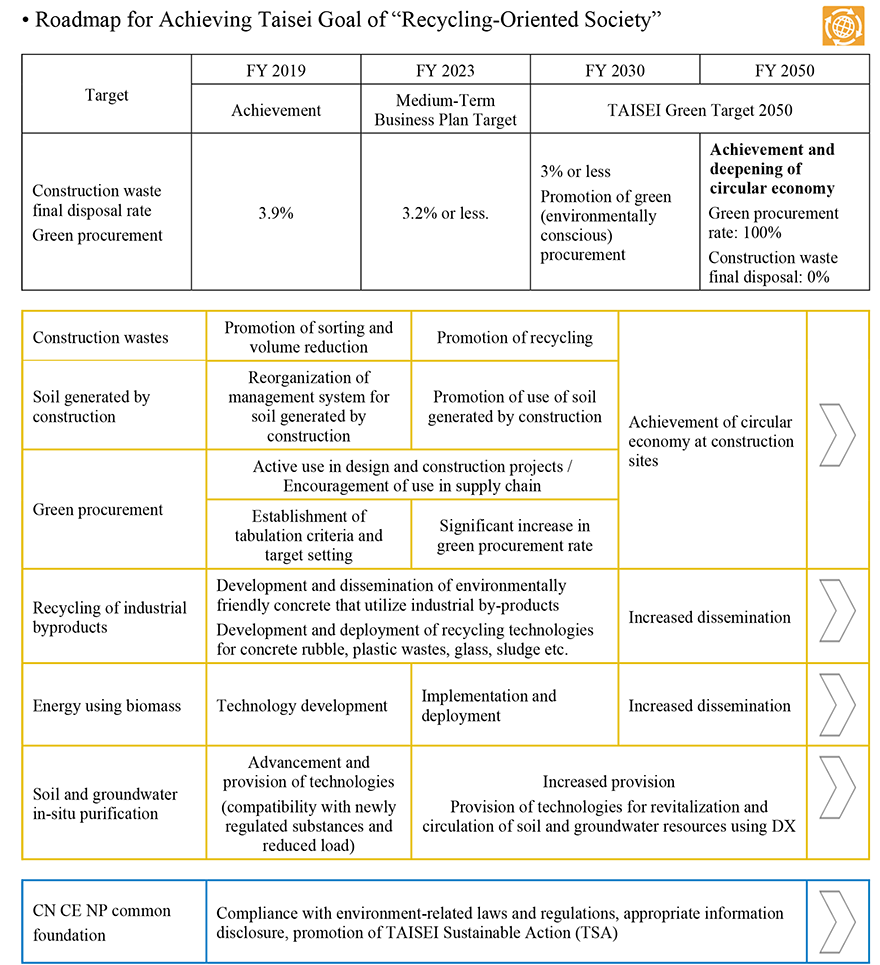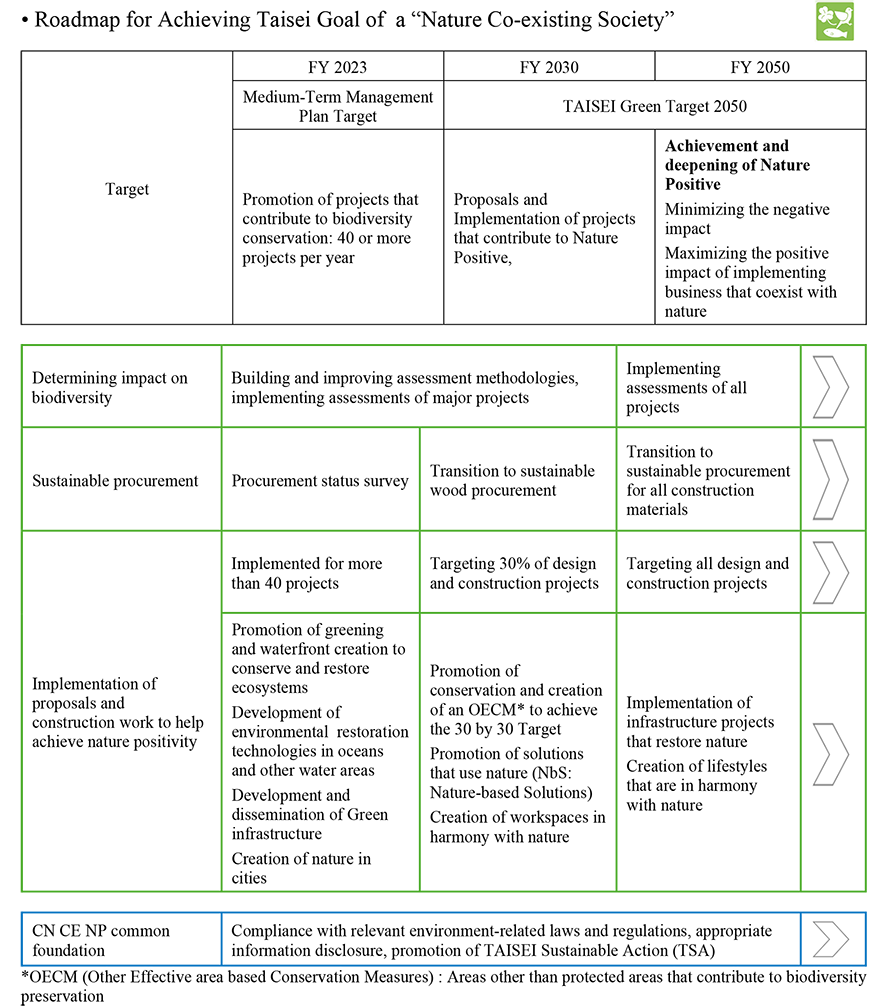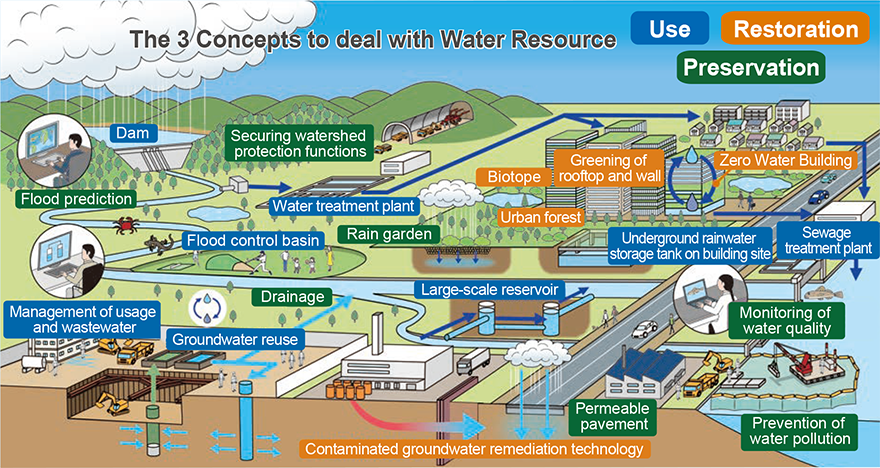- HOME
- Environment(E)
- Realization of a Sustainable and Environmentally Friendly Society
- TAISEI Green Target 2050
TAISEI Green Target 2050
Group’s Long-Term Environmental Targets (TAISEI Green Target 2050) to achieve the “Realization of a Sustainable and Environmentally Friendly Society”
Based on the Taisei Group Philosophy “To create a vibrant environment for all members of society” and our Fundamental Policy on Sustainable Development, the Taisei Group strives to build good quality social capital through corporate activities centered on construction business in harmony with nature.
The Taisei Group established a long-term environmental target (TAISEI Green Target 2050) to achieve the “Realization of a Sustainable and Environmentally Friendly Society”. We will work with the whole supply chain, together with the stakeholders to achieve these environmental targets by defining our “Responsibilities”, “Contributions Through Our Business”, and “Activities / Efforts” to confront the three types of societies as “Decarbonized Society”, “Recycling-Oriented Society”, and “Nature Co-Existing Society”, and to address the two individual issues as “Forest Resources/Forest Environment” and “Water Resources/Water Environment”.
| FY2030 Target | FY2050 Target | ||
|---|---|---|---|
Decarbonized Society
 |
CO2Total emissions (compared to FY2022) | Scope 1 + 2 -42% Scope 3 -25% |
CN: Achieving and deepening carbon neutrality
|
Recycling-Oriented Society
 |
|
CE: Achieving and deepening circular economy
|
|
Nature Co-Existing Society
 |
Contribute to Nature Positive
|
NP: Achieving and deepening nature positive
|
|
Targets for addressing two individual issues
|
Forest Resources & Forest Environment
|
|
Water Resources & Water Environment
 |
|

Compliance with Environment-related Laws and Regulations, etc.
In addition to complying with environment-related laws and regulations throughout the Group, we will achieve “Zero Environmental Accidents” at work sites based on the “Priority Management Items for Work Sites” and other items set forth by our Safety Division.
Compliance with Environment-related Laws and Regulations
TSA:TAISEI Sustainable Action®, Environmental Impact Reduction Activities
All Group employees participate in activities to reduce environmental impact. A TSA Action List indicating specific technologies and activities that are effective in reducing environmental burdens has been prepared, and the effect of the activities is visualized and quantitatively evaluated using the TSA Point System with the purpose to lead to increased awareness and changes in behavior of our employees.
TSA:TAISEI Sustainable Action®
Three types of Societies
1. For Realization of a Decarbonized Society
Responsibilities
As construction is the core business of the Taisei Group, the Group has a keen awareness of the effect of its business activities on the transition to a decarbonized society and the impact of the transition to a decarbonized society on business activities. We consider it to be our responsibility to reduce CO2 emissions from business and related activities to zero by 2050.
Contribution Through Our Business
The Taisei Group identifies the risks and opportunities in anticipation of the achievement of a decarbonized society. We strive to develop and disseminate technologies and services relating to energy-savings, decarbonization of construction materials, renewable energy and so on, and to promote possession of renewable energy power sources, so as to contribure to a decarbonized society.
Activities / Efforts
- 1.Setting and managing Group environmental targets
・Managing Group environmental targets based on a climate-related governance system
・Acquisition of SBT re-certification at the 1.5°C level
・Use of Internal Carbon Pricing (ICP) to promote decarbonization-related capital investment, investment in the
development of decarbonization-related technologies, and promotion of TAISEI Sustainable Action (TSA)
2. Reduction of CO2 emissions from business activities
- Infrastructure development
・Introduction of T-CARBON®/ Watch at all work sites / introduction of T-CARBON E-Site - TSA|Promotion of TAISEI Sustainable Action®
・Identification of priority action items for implementation / Use of TSA point system / Reduction of energy use - Utilization of renewable energy
・Possession of renewable energy power sources with the aim of covering Group power consumption by 2030
・Use of non-fossil certificates (NFCs), J-credits etc. - New capital investment that contribute to decarbonization
・Implementation of investment based on criteria in line with the Group’s environmental targets
3. Reduction of CO2 emissions in the supply chain
- Development and dissemination of decarbonized construction materials
・Development and dissemination of T-eConcrete® / Development and dissemination of T-Wood® / Creation of J-credits - Promotion of engagement
・Implementation of Environmental due diligence
・Ensuring a thorough understanding of the Sustainable Procurement Guidelines
・Cooperation with specialized construction companies with regard to TSA
4. Reduction of customer CO2 emissions
- Development and dissemination of ZEB, ZEF, ZEH and ZEH-M
・Development and commercial application of next-generation advanced ZEB / Dissemination of "Green Renewal ZEB" / Development and dissemination of energy-saving equipment such as T-Green® Multi Solar / Dissemination of energy
support services / Development and dissemination of T-ZEB simulator - ZCB|Promotion of Zero Carbon Buildings
Demonstration at the Taisei Group’s Satte Research Institute
・Development and dissemination of T-ZCB® system for evaluating effectiveness in reducing CO2 emissions
・Use of T-LCA Simulator and T-ZCB® Chart
5. Development and dissemination of advanced decarbonization technologies
- CCS (Carbon Capture and Storage)
- Carbon Capture, Usage and Storage (CCUS) (Carbon Recycled CO2 geothermal power generation technology, etc.)
- Use of hydrogen, ammonia and other new types of energy sources
- Conservation and regeneration of blue carbon ecosystems

2. For Realization of a Recycling-Oriented Society
Responsibilities
As construction is the core business of the Taisei Group, the Group has a keen awareness of the effect of its business activities on the transition to a recycling-oriented society and the impact of the transition to a recycling-oriented society on business activities. We consider it to be our responsibility to increase the green procurement rate and reduce the final disposal rate of construction byproducts, in order to achieve a circular economy.
Contribution Through Our Business
The Taisei Group identifies the risks and opportunities in anticipation of the achievement of a recycling-oriented society. We strive to develop and disseminate technologies and services relating to soil and groundwater contamination countermeasures, appropriate management of wastes and final disposal sites and so on, and to promote recycling of industrial byproducts, in order to contribute to a recycling-oriented society.
Activities / Efforts
1. Reduction of construction / industrial waste final disposal rate
- Compliance with The Plastic Resource Circulation Act
・Establishment of targets for preventing discharge and promoting recycling / Study and implementation of specific
measures to prevent discharge and promote recycling - Waste recycling
・Promotion of recycling of materials using a patrol and collection system / Study of the use of sludge,
wood and other valuable resources - Appropriate management of construction surplus soil
・Study of methods for grasping the amount of surplus soil using a management system for construction surplus soil, etc. and appropriate management methods / Study of enhanced use of surplus soil between construction site
2. Green procurement
- Use of the Green Procurement Guidelines in collaboration with suppliers
- Adoption of green procurement items during construction design
- Use of recycled materials
3. Soil and groundwater contamination countermeasures
- Provision of purification technologies that match the contamination status
- Development of new purification technologies
・Purification technologies with low CO2 emissions / Improved efficiency and reliability through the use of DX
4. Waste sorting and volume reduction technologies
- Sorting and processing of buried wastes
- Measures to deal with natural disaster waste
・Development of technologies to quickly determine the proportion of flammable materials through the near-infrared
imaging by drone
5. Final disposal site technologies
- Waterproof diagnostic system
- Revitalization of final disposal sites
6. Development and implementation of related technologies and services to promote a recycling-oriented society
- T-e Concrete® using industrial byproducts
- Energy generation using biomass from wastes
- Study of the use of concrete rubble, glass shards and other construction wastes

3. For Realization of a Nature Co-Existing Society
Responsibilities
As construction is the core business of the Taisei Group, the Group has a keen awareness of the effect of its business activities on the transition to a nature -co-existing society and the impact of the transition to a nature -co-existing society on business activities. We observe the Declaration of Biodiversity Preservation by Taisei Group and consider it to be our responsibility to minimize the adverse impact of construction business on the natural environment and biodiversity.
Contribution Through Our Business
The Taisei Group identifies the risks and opportunities in anticipation of the achievement of a nature co-existing society. We strive to develop and disseminate technologies and services relating to conserving and restoring natural environments and enhancing biodiversity, and to promote activities that co-exist with nature and maximize the positive impact on the natural environment and biodiversity, in order to contribute to the realization of a nature co-existing society.
Activities / Efforts
1. Creation of added value related to conservation and creation of the natural environments
- Proposals to achieve co-existence with natural environments
・Promotion of active proposals to help protect natural environments and enhance biodiversity
・Promotion of proposals to introduce green infrastructure with multifaceted functions
・Creation of added value related to conservation of the natural environment and biodiversity
・Promotion of proposals to achieve the 30 by 30 Target - Construction that considers the natural environment and biodiversity
・Promotion of construction that considers the natural environment and biodiversity in order to minimize the impact on
the natural environment and help achieve nature positivity - Support for operation and management
・Promotion of support for operation and management in order to conserve the natural environment and biodiversity
2. Development of technologies to achieve a nature co-existing society
- Development of technologies to protect and create good natural environments
・Development of planning and assessment technologies to protect and create natural environments / Development of
construction technologies to protect the natural environment
3. Promotion of cooperation to achieve a nature co-existing society
- Promotion of activities to protect the natural environment in cooperation with stakeholders
・Promotion of activities in cooperation with specialized construction companies and other contractors
・Promotion of activities in cooperation with local communities, NPOs, NGOs etc.
・Promotion of sustainable use of ecosystem services in cooperation with customers
・Promotion of environmental education activities that lead to changes in individual behavior - Participation in initiatives, etc.
・Participation in initiatives etc. that help to achieve a nature co-existing society

Two Individual Issues
1. For Resolving individual issues related to the Forest Resources and the Forest Environment
Responsibilities
As construction is the core business of the Taisei Group, the Group has a keen awareness of the effect of its business activities on forest resources and the forest environment and the impact of forest resources and the forest environment on business activities. We consider it to be our responsibility to minimize the adverse impact of construction business on forest resources and the forest environment, by implementing wood procurement zero deforestation.
Contribution Through Our Business Responsibilities
The Taisei Group identifies risks and opportunities related to forest resources and the forest environment. We strive to develop and disseminate technologies and services relating to conservation, creation and restoration of forest resources, and to promote business activities that are in harmony with nature in order to maximize the positive impact and contribute to achieve sustainable forest resources and forest environments.
Activities / Efforts
1. Sustainable wood use
- Appropriate wood procurement
・Wood procurement status survey and guidance
・Sustainable wood procurement - Promotion of wooden construction
・Promotion of local wood use
・Promotion of reuse and recycling of wood
2. Restoration of forest resources
- Sustainable use of planted forest
・Promotion of wooden construction
・Support for sustainable forest management - Conversion of planted forests into natural forests
・Creation of forests that function as green infrastructure through conversion of planted forests into natural forests
3. Conservation of good forests
- Evaluation of forest
・Visualization of multifaceted functions of forests - Conservation activities
・Implementation of forest conservation activities in cooperation with companies and communities

| Sustainable wood use | Restoration of forest resources | Conservation of good forests |
|---|---|---|
Appropriate wood procurement
|
Sustainable use of planted forests
|
Evaluation of forest
|
Promotion of wooden construction
|
Conversion of planted forests into natural forests
|
Conservation activities
|
2. For Resolving individual issues of the Water Resources and the Water Environment
Responsibilities
As construction is the core business of the Taisei Group, the Group has a keen awareness of the effect of its business activities on water resources and water environment and the impact of water resources and water environment on business activities. We consider it to be our responsibility to exercise appropriate management and reduce water use, in order to minimize the adverse impact of construction business on water resources and water environments.
Contribution Through Our Business Responsibilities
The Taisei Group identifies risks and opportunities related to with water resources and water environments. We strive to develop and disseminate technologies and services relating to conservation and restoration, and to promote business activities that are in harmony with nature in order and to maximize the positive impact and contribute to sustainable water resources and water environments.
Activities / Efforts
1. Sustainable water use
- Effective use and reduction of water use (the Water 3Rs)
・Effective use of water resources and efforts to save water through TSA at all workplaces
・Promotion of the use of reclaimed water, treated wastewater and rainwater
・Collection and management of data on water use and discharge - Contribution to construction of water infrastructure facilities
・Construction of infrastructure facilities (dams, water and sewerage facilities, underground rainwater storage tanks for
buildings, permeable pavement etc.) and green infrastructure facilities (flood mitigation dams, flood control basins,
rain gardens etc.) - Business activities in high water stress regions
・Study of the use of water resources in high water stress countries and regions, and implementation of measures
・Management of business activities that impact regional water resources and appropriate response to droughts, etc.
2. Restoration of water resource
- Development and dissemination of technologies and services
・Efforts to develop technologies to achieve Net Zero Water through Zero Water Buildings, etc.
・Enhancement of evapotranspiration function by greening rooftop and walls and urban forest cultivation
・Proactive adoption of water-saving/design and equipment at properties designed and constructed by Taisei and
Taisei-owned buildings etc. - Restoration of water environment
・Research and development of technologies to restore biotopes and other water environments and application to
construction work
・Development of water environment monitoring technologies
・Cooperation with stakeholders (government agencies, local communities, orderer, subcontractors etc.) with regard to
environmental assessments, etc. - Purification of contaminated soil and groundwater
・Development of technologies to perform low-load purification of contaminated groundwater and application to
construction work
3. Conservation of water resources
- Reduction of water environment burden
・Prevention of water contamination during construction
・Appropriate management of construction wastewater based on laws and regulations
・Development and application of technologies for monitoring water quality and environment - Conservation of groundwater
・Securing the watershed protection functions of forests
・Development of groundwater conservation construction technologies and application to construction work - Contribution to flood prevention, restoration etc.
・Rapid response for disaster recovery
・Development and use of flood prediction, assessment and response technologies

| Sustainable water use | Restoration of water resources | Conservation of water resources |
|---|---|---|
Effective use and reduction of water use (the Water 3Rs)
|
Development and dissemination of technologies and services
|
Reduction of water environment burden
|
Contribution to construction of water infrastructure facilities
|
Restoration of water environment
|
Conservating of groundwater
|
Purification of contaminated soil and groundwater
|
Contribution to flood prevention, restoration etc.
|
